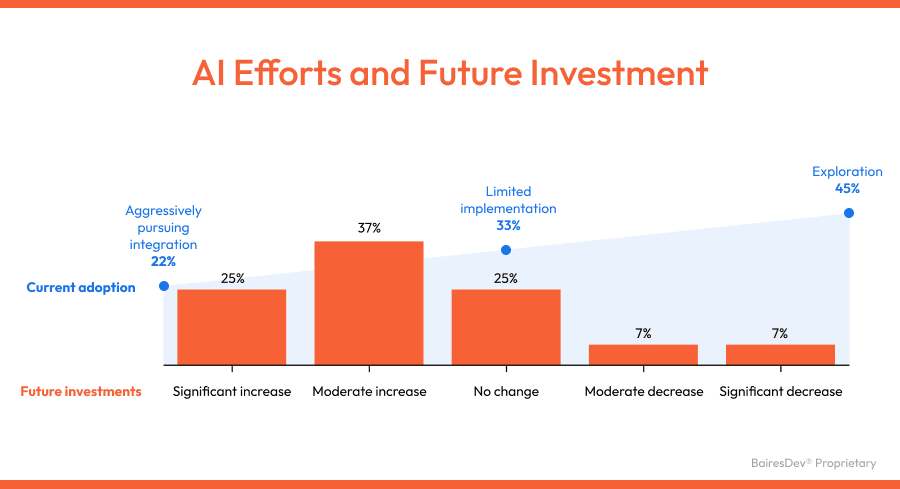Are you among the ranks of those tasked with developing a proprietary AI product within the year? In Q2 2024, we saw a 383% increase in clients requesting engineers with machine learning skills, showing a rise in AI/ML interest compared to Q2 2023. Despite the hype, many stories of AI products going off the rails should make any Engineering leader think twice. Rushing AI product development could lead to serious issues.
In 2023, CNET, a tech media site, revealed that 41 of its 77 AI-generated articles contained factual errors. On the launch demo of Google’s AI chatbot Bard, it erroneously replied that the James Webb Space Telescope took the first-ever pictures of an exoplanet. This was incorrect, as it was the European Southern Observatory’s Very Large Telescope, something a quick Google search could tell you. It is no surprise that only 22% of surveyed companies by CompTIA are “aggressively pursuing AI integration”, while 45% are still exploring potential AI adoption.
As shown in the chart, over 60% of surveyed companies plan to increase their AI investments despite ongoing uncertainty. If your company is preparing for AI projects, it’s crucial to avoid common mistakes associated with internal AI development, particularly if you’re leading the first deployment attempts. Keep on reading if you’re wondering how can you balance the board’s, CTO’s, developers’, and marketing teams’ eagerness to launch a new AI product.
Get the AI Foundations Right
You have to learn the letters before reading a book. Similarly, choosing a solid software foundation will set your project up for success. A basic example could be choosing a word-processing document vendor. Where you could take your pick of any number of word processing documents for pennies or even free, most companies choose Google Docs or Microsoft Word. Why? These products are compatible with the main market solutions, have security features, are responsive, etc. Similarly, if you begin an ambitious AI project with a cheap model, you will run into trouble down the road. Let’s explore why.
Mistake #1: Choosing Cheap Models to Start Your AI Journey
In 2024, AI is a core element of making processes more accurate, less cumbersome, and more automated. It has the potential to amplify productivity and automate growth, but it has the potential for security breaches. With this in mind, choose an AI model with enough oomph to get the job done because you should not be efficient before being effective. If the model is cheap, it will require more prompt engineering, and it’ll be harder to scale.
There are many scenarios where the right AI model makes all the difference – like when developing an MVP. It might turn out that the inexpensive model you’re considering just won’t work for this purpose. Even if it does work initially, an MVP is often built with the intention of scaling up if it proves successful. If it’s built on a low-cost AI model that struggles to scale, it can lead to losses. This will result in a rather short lifespan for your MVP.
Some industries like finance and healthcare are dependent on data integrity and speed. Cheaper AI models might compromise data privacy to reduce costs. For example, GPT-2 and GPT-3 by OpenAI and Hugging Face Transformers were trained on public datasets. Without specific anonymization, these models might unintentionally generate outputs that reveal sensitive information from their training data. If you tap into a similar model your data privacy could be compromised.
Don’t opt for the cheapest AI model on the market. It’s an investment piece in your software repertoire.
Mistake #2: Marrying One AI Vendor
We’ve addressed before a few risks of vendor lock-in when businesses undertake digital transformation efforts. AI development is no exception. The consequences of relying on a single AI vendor include:
- Limited flexibility and customization as your vendor may not adapt to changing needs. You may be pushed to compromise on features critical to your success. Remember that prompt engineering is tailored to the model you’re working with. For example, by the time you’re developing your front end, you won’t be able to switch from, say, OpenAI to Anthropic. It will be a much different challenge.
- Vendor lock-in binds you to a contract and can mean high costs and complexity if you need to switch. Migrating technologies to new areas is not as simple as unplugging your Wi-Fi router and switching plans. In AI, the ETL pipelines, data streams, and encryption services need to be reconnected, tested, and maintained to avoid security breaches and downtime.
- Potential innovation gaps in your vendor could mean you miss opportunities for better solutions from other vendors. AI is innovating constantly but not concurrently in all vendors.
- Using one AI model increases risk concentration. When Crowdstrike went down, 8.5 million Windows devices depended on their team to restore functionality. In the experimentation phase, avoid increased vulnerability to vendor-specific issues, like a security breach, or else your systems could be vulnerable, too.
Remove yourself from the line of fire by courting several AI vendors until you find the one. Hire AI developers who can adapt prompts to various models like OpenAI, Anthropic, or Llama. AI teams that master multiple models can avoid vendor dependence and ensure adaptability, agility, cost-effectiveness, and flexibility.

Mistake #3: Partnering With an Inexperienced Tech Firm
While Large Language Models and GenAI represent a new market, some firms already have enough experience integrating these technologies into their internal operations. For instance, our engineers have worked on internal AI projects to diminish churn and enhance talent retention. This initial knowledge and experience enabled us to develop successful custom solutions for our clients. For example, we built a legal summary tool that saved a client hours of manual transcription work. In these projects, our engineers tested OpenAI and Microsoft Azure’s models, flipping through the two to see the benefits and settling on the latter for data privacy guarantees.
We developed algorithms for a wellness industry client to process biometric data collected via wearables. Additionally, we also produced documentation for algorithm repositories for government agencies. Through these efforts, we have gained valuable insights and best practices in a field where the playbook is yet to be written. As you browse through tech firms’ portfolios, you should check for some hands-on AI experience.
Focus on the Core Problem
It’s easy to get distracted by superficial inquiries. Remember, you’re not starting an AI project just for the sake of it; you’re using AI to address real business or operational challenges. As we discussed earlier, efficiency follows effectiveness. So, focus on the solution itself rather than its good looks. In AI, you need the very basics working from the beginning, not an impressive UI design. Let’s explore where you should focus your efforts to ensure your AI delivers real value to your business.
Mistake #4: Large Teams Chasing ‘Nice to Haves’ Instead of Addressing Core Problems
Skip the front end until the back end does its job. Begin looking at the mechanics of AI with small, specialized teams. The more people you add to your team, the more opinions and the less agility. In 2023, our team built AI software that reduced the time for sales call auditing by 95%. The tool isn’t elegant, the UI is rather rough. However, it’s functional and pays for itself in value. Front-facing features (like fancy buttons/fonts/chatbots) can easily become a burden.
Imagine you’re adding an LLM to your growth marketing strategy to personalize product recommendations via a chatbot. If the LLM pulls data from an outdated source. It might start suggesting products that aren’t available or have sold out. It could even misunderstand data, fail to target customers correctly, and recommend inappropriate products. Focus on the tool’s effectiveness. If not, you’ll be waving goodbye to customers and paying for useless artificial intelligence.
Mistake #5: Selecting Broad Projects With Low Chances of Success
You can make your whole organization turn against future initiatives if the first AI projects fail. If you’re championing these initiatives, this means you could face resistance in your next AI endeavors. To ensure success, start small. Tackling a broad AI project is like swimming across an ocean. You start strong when the shore is in sight behind you, but further offshore you lose direction and risk drowning. A small, well-defined project is like swimming in a pool with clear edges, making it easier to reach your goals. Your AI strategy should allow small projects to be deployed and give stakeholders low-risk opportunities to work with AI.
Imagine that a company decided to overhaul its core product with AI. It would demand extensive resources and time to develop, but also a steep learning curve from customers. Presenting an entirely new product could alienate users who prefer the previous version. In contrast, the company should introduce a small AI feature that, for instance, helps users save time on a specific task. This feature can gradually build user and developer confidence in AI and pave the way for more ambitious projects. If done successfully, this approach can quiet the naysayers.

To avoid people exclaiming AI is a fad, your initial projects should be those you have a high degree of understanding. Let’s call it AI scaffolding. Begin by teaching your user (and devs) how to use one AI feature. Build their confidence over several weeks and then introduce a consecutive feature. The rewards and gains will be tangible, and people will receive AI initiatives with openness.
These five guidelines can help you build internal support, manage expectations, and ride the AI wave without wiping out in the middle.
Conclusion
Baby AI steps are better than gaping AI mistakes. Remember to implement these 5 strategies:
- Avoid cheap AI models, they often lead to higher costs and reduced effectiveness.
- Diversify your AI vendors to maintain flexibility and keep your team versed in different models.
- Partner with experienced firms to leverage best practices in this evolving AI market.
- Start with clear, small AI projects to build confidence and prevent setbacks.
- Prioritize solving the core problem with small teams before expanding to front-end enhancements.
There’s plenty of AI real estate out there, but as a company, you should be cautious about your AI projects. A good AI strategy should build in scale, initially be led by small teams, consider experienced vendors, and bring real value to your services rather than drain resources. It may even be the year to allocate a Chief AI Officer to oversee your AI roadmap and hiring strategy.
Still a bit hesitant about addressing your operation or business challenges with AI/ML? Reach out to us. We’ll be happy to help define the best course of action.







